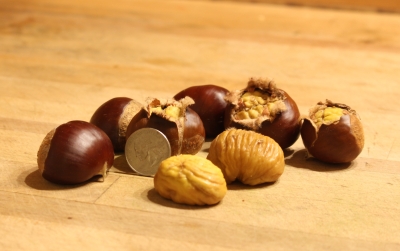NUTS OVER CHESTNUTS
/6 Comments/in Fruit, Gardening, Planning/by Lee ReichAmerican Chestnuts, Gone but not Dead
The chestnuts are big and fat and tasty — obviously not American chestnuts. I harvest so many chestnuts, also big and fat, each year from my Colossal variety trees that I never bothered to look beneath my Marigoule trees. Marigoule is planted further from my house than Colossal.
American chestnuts, Castanea dentata, are small but very tasty, or so I have read and heard. I’ve never tasted one. The trees were devastated by a blight throughout the early 20th century. Previous to blight, the trees were so numerous in our eastern forests that it was said that a squirrel leaping from one chestnut branch to another could travel from Maine to Georgia without touching the ground.
Something like 40 billion trees died to the ground. But roots survive, sprouting new shoots each year to provide a host to keep the blight fungus alive. Trees might even grow to have trunks a half-foot or more in diameter before the fungus strikes to cut the tree to the ground again.
A Tale of Blight, Pollination, and Staining
Various chestnut species inhabit different parts of the world. Most blight resistant are Chinese chestnut (C. mollisima) and Japanese chestnut (C. crenata), where the blight originated. European chestnuts (C. sativa) is susceptible to blight, so has been mated with the Chinese or Japanese species to yield resistant, tasty hybrids. My Colossal and Marigoule trees are hybrids of the European and Japanese species.
But the plot thickens. Colossal, though a hybrid, is only slightly resistant to blight. My tree, over 15 years old, exhibits no sign yet, but I’m keeping an eye out for telltale orange pustules on its bark, limb dieback, and massive resprouting below points of infection. (It is only more recently that Colossal was determined to be more susceptible than originally thought.)
Marigoule is quite resistant to blight. The tree also has an elegant, upright form, more like that of American chestnuts.
So what’s the problem? If blight were to eventually strike Colossal dead, I could just walk a little further and gather Marigould nuts from the ground. Except that any chestnut tree needs cross-pollination from another variety in order to bear nuts.
When I planted Colossal and Marigoule, I also planted some other chestnut trees, blight resistant Chinese chestnuts: a seedling and the varieties Peach and Eaton, the latter of which also has Japanese and American chestnuts in its parentage. All these yield good-tasting nuts, though not nearly as large and easy to peel as Colossal and Marigould, all are blight resistant, and any of them could pollinate Marigoule. Problem solved? Not quite.
The plot thickens further. The nuts of Colossal, Marigoule, and other Japanese and Japanese hybrid chestnuts sometimes get a black staining that ruins their quality. Not all the nuts, just some of them. Recent research pins the blame not on yet another disease, but on pollen from Chinese or Chinese hybrid chestnut trees.
Nutty Present and Futures
Going forward, I’m keeping a close eye on Colossal. If Colossal gets sick, one option that, so far, has been effective only in Michigan, might be to infect the blighted trees with a blight fungus that has been weakened because of infection with a virus. The weakened fungus is less deadly.
Or, I could cut down Colossal and Marigoule, and feast only on the Chinese chestnuts and their hybrids. But Colossal and Marigoule are both so productive and produce such large, tasty, easy to peel nuts.
I could cut down the Chinese seedlings and hybrids to prevent their pollination and staining of Colossal and Marigoule nuts. Except I’ve recently discovered that my Marigoule must have been pollinated by one of my Chinese trees because Colossal is pollen sterile. Marigoule can pollinate Colossal, but not vice versa. So to get nuts on Marigoule without Chinese chestnut pollen, I’d need another Japanese chestnut or hybrid, either a whole new tree or a branch grafted on either Colossal or Marigoule.. The variety Labor Day (also known as J60) yields good nuts and is blight resistant.
I’ll probably take the “wait and see” option. After all, there’s no sign of blight on any trees; few nuts get staining; and we gather more than enough nuts for roasting and stews.
CLEAN UP, THEN SHAVE
/14 Comments/in Flowers, Fruit, Gardening, Pests, Soil, Vegetables/by Lee ReichOut with the Old (Plants)
Ostensibly, I’m clearing away old plant debris from the vegetable and flower gardens to spare next year’s garden a full onslaught of overwintering disease and insect pests, and so that, come spring, the soil is ready and waiting for seeds and transplants. I’ll admit it, though: I like the garden looking neat going into late autumn. As Charles Dudley Warner wrote in his book My Summer in the Garden (1889), “the closing scenes need not be funereal.”
As of this writing, frost has not yet struck; as of your reading, it probably will have. Following that event, I will remove all dead plants. I’ll grasp the tops of smaller plants, such as marigolds and basil, give them a twist to sever the smaller roots, then lift and toss the plant into a waiting garden cart. If I tried to do that with old pepper, tomato, or okra plants, they would laugh at me. I lop off the bulk of their tops, then cut around the plant with a Hori-hori knife so that I can lift the remaining stem and main roots out of the ground.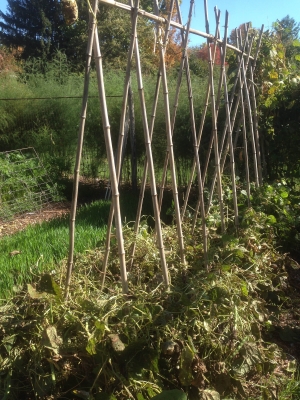
In either case, my goal is to remove everything but the smaller roots. Left in place, they’ll rot to add organic matter to the soil, leaving behind channels to let air, water, and creatures move through the ground.
Even now, before frost, cleanup is well under way. Tomatoes are spent; I cleaned them up yesterday. Beans are spent; I’ll clear them away today. Leaving bean roots in the soil is like sprinkling organic fertilizer from the free nitrogen they gathered from the air.
Along with garden plants, weeds also get cleared away, again removing only top portions and the main roots. Small roots don’t have the energy to re-sprout.
In With the New (Compost)
More than just looking neat, the cleaned up garden is — to my eye — ornamental. Think of the calm beauty of Zen gardens, some of them little more than boulders and raked gravel. Mine is wood chips (in paths) and raked soil.
Well, not really raked soil. Bare soil looks ugly to me because I know it’s too exposed to rain and wind. So as soon as I’ve cleared a bed, I immediately put a blanket on it. Before the end of September, that blanket was oat seed topped with an inch of compost. Those beds are now lush strips of green. Post-September beds get blanketed with just an inch of compost. It’s roughness helps protect the surface, and next spring I can sow seeds or plug transplants right into it. That much compost is all the nourishment plants will need for the whole growing season next year.
And then there are the beds still green with carrots, turnips, endive, lettuce, kale, and other cold-hardy plants. I’ll dig the root crops, for storage, at my leisure. The others, we will eat, also at our leisure.
Nothing Wasted
All that stuff that I am clearing out of the garden is going right into the compost pile. Yes, everything! I’m occasionally asked if I put leaves and stems that are infected or infested with blight, aphids, or other pests into my compost pile. Yes! Everything goes into the pile.
I contend that if you looked closely enough (perhaps needing a microscope) at almost any leaf, stem, fruit, or root, you’d probably find some evidence of a “bad guy” on it. No matter. The combination of time and temperature within any compost pile does them in.
This time of year, piles build rapidly. By paying attention to water and air within the pile as well as the balance of high nitrogen materials (manures and lush greenery such as vegetable plants and young weeds) and high carbon materials (old, browning plants, wood chips, autumn leaves), I’m able to get my compost piles up to 160° F.
Soon, cooler temperatures combined with less stuff to feed the pile makes for cooler composting. I let these piles “cook” longer, the longer time making up for lower temperatures.
Lookin’ Good and Ready for Spring
Getting everything ready for winter is a leisurely process, inching along over the next few weeks. By then, tender vegetable plants and weeds will have been tucked into compost piles and beds will be blanketed in either compost, compost and growing oats, or late fall vegetables. Mr. Warner, mentioned in my opening paragraph, went on to say, “A garden should be got ready for winter as well as for summer . . . I like a man who shaves (next to one who doesn’t shave) to satisfy his own conscience, and not for display, and who dresses as neatly at home as he does anywhere. Such a man will be likely to put is garden in complete order before the snow comes, so that its last days shall not present a scene of melancholy ruin and decay.”
I’m going to shave now.
Luxuriating in my Greenhouse
/7 Comments/in Fruit, Gardening, Planning, Vegetables/by Lee ReichHow Cool is That (Greenhouse)?
Having a greenhouse is a much-appreciated luxury. To avoid being profligate, I eke all that I can from its every square inch in every season.
For starters, it’s a cool greenhouse — temperature-wise “cool,” not “ain’t this a cool greenhouse” cool. Winter temperatures are permitted inside drop to 35°F. before the propane heater kicks on. And in summer, roll-up sidewalls let in plenty of cooler, outside air to save energy (and noise) in running the cooling fan. Demands on the cooling fan are also minimized by letting summer temperatures reach almost 100°F. before the fan awakens.
I have to choose my plants carefully for them to tolerate such conditions.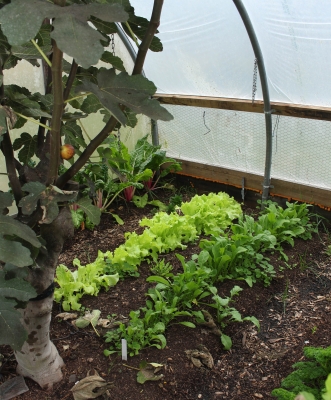
Right now, lettuce, arugula, mâche, celery, parsley, kale, and Swiss chard seedlings and small transplants trace green lines up and down ground beds in the greenhouse. I sowed seed of most of these cold-loving vegetables about a month ago. They’re too small to harvest now. No matter: The outdoor vegetable garden is still replete with greenery available for harvest through November and, probably, on into December. By then, greenhouse greenery will have grown to harvest size, then continue to do so very slowly through the dark, cold days.
And the 100° summers in the greenhouse? Above the beds spread the branches of three large fig trees, planted right into the ground (rather than pots). From those branches dangle ripe and ripening figs, as they have since July. Figs originated in the searing heat of summers in Western Asia; they can take the 100° heat of my greenhouse. Soon, cooler temperatures and lowering sun will drive the trees to stop ripening fruits, and lose their leaves and enter dormancy. (Figs are subtropical, rather than tropical, trees, so enjoy a cool — but not frigid — winter rest.) The few, leafless branches, most of them pruned back, will cast little shade to let the cool weather greenery in the ground beds below bask in what little sunlight fall and winter have to offer.
Starting in February, my greenhouse does triple duty, becoming also a home for transplants for the upcoming season’s vegetable and flower gardens. I plant the first seeds — onions, lettuce, celery, and leek — in early February, sowing them in seed flats on the narrow bench along the greenhouse’s north wall.
(Hot) Beds in Summer
As each spring morphs into summer in the greenhouse, fig growth begins anew and winter’s cool weather vegetables wane and are cleared away.
How about putting the ground beds beneath the awakening fig trees to some good use? In the past, I’ve tried growing melons and cucumbers, all of which originated in hot regions of Africa and Asia, in those beds. Neither the melons nor the cucumbers did particularly well — yet.
Ginger Loved the Heat
Which brings us to this week’s ginger harvest. Greenhouse beds this summer provide a warm, moist home in which to grow ginger, a plant indigenous to the hot, muggy climate of south China. Ginger would be hardly worth growing if all I wanted was the khaki-skinned rhizomes that I could pick off a supermarket shelf. Those tough-hided roots are mature ginger, which has a fibrous flesh.
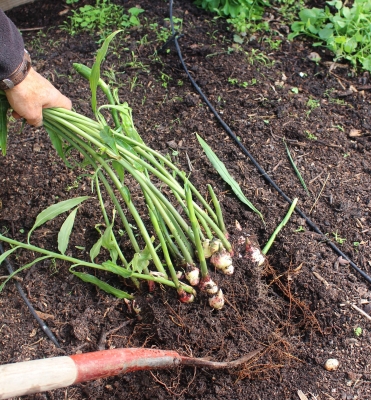 What I was shooting for was baby ginger, whose pink-tinged, white skin, encloses flesh that is tender, lily-white, and free of fibre. The flavor is a little different than mature ginger, cleaner. This tropical plant I figured could — and it did — thrive in my hot greenhouse all summer.
What I was shooting for was baby ginger, whose pink-tinged, white skin, encloses flesh that is tender, lily-white, and free of fibre. The flavor is a little different than mature ginger, cleaner. This tropical plant I figured could — and it did — thrive in my hot greenhouse all summer.
To get started, way back in March, I purchased a single root of mature ginger at the supermarket, broke it into four sections, and potted each section into a 4 inch pot. As I said, the plant needs heat, so I set the pots on my seed-starting mat to maintain a temperature of about 70°F. Still, it took awhile for green sprouts to show.
The potted ginger plants were ready to plant out in a greenhouse bed just as the last of winter’s vegetables were being cleared away there. After planting, I refurbished the soil with a mulch of compost. Cool soil got the plants off to a slow start but once summer heat kicked in outdoors, and then really kicked in within the greenhouse, the ginger thrived.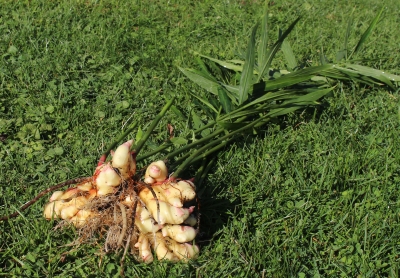
The goal was to let ginger linger to eke maximum yield but not so long that the rhizome would begin to mature. I also needed space for this winter’s plantings. As it turns out, the first objective, maximum yield, was moot. Yields were prodigious, four plants yielding much more than we could possibly eat.
Pickle It
The first order of business with the harvested baby ginger was to pickle it. All that was needed was to slice it thinly with a carrot peeler then pour boiling vinegar sweetened with a bit of maple syrup over it.

